Cosmology
1/128
There's no tags or description
Looks like no tags are added yet.
Name | Mastery | Learn | Test | Matching | Spaced |
|---|
No study sessions yet.
129 Terms
What are the eight celestial bodies (or objects) that are visible with the naked eye?
Stars, sun, moon, mercury Venus, Mars, Jupiter and Saturn.
These objects block out stars as they move in front of the stars (they are closer to us than stars).
How did the Greeks predict the motion planet and stars?
Placed the eight visible celestial bodies on rotating spheres, as they rotated around earth (geocentricism).
The problem is that sometimes the celestial bodies loop backwards and motions are not always circles.
What is heliocentrism?
Heliocentrism is an astronomical model where the Sun, rather than the Earth, is considered the center of the solar system, with the Earth and other planets orbiting it.
What are arguments against heliocentrism?
What is Olber’s paradox?
If the Earth orbits the Sun, nearby stars should appear to shift their position relative to distant stars at different times of the year due to parallax.
Parallax is the apparent shift in the position of an object when viewed from different perspectives.
Olber’s paradox - under the presumption that the universe is infinite, any direction we travel in the universe should lead to a star. This means the night sky should be excessively bright like the sun.
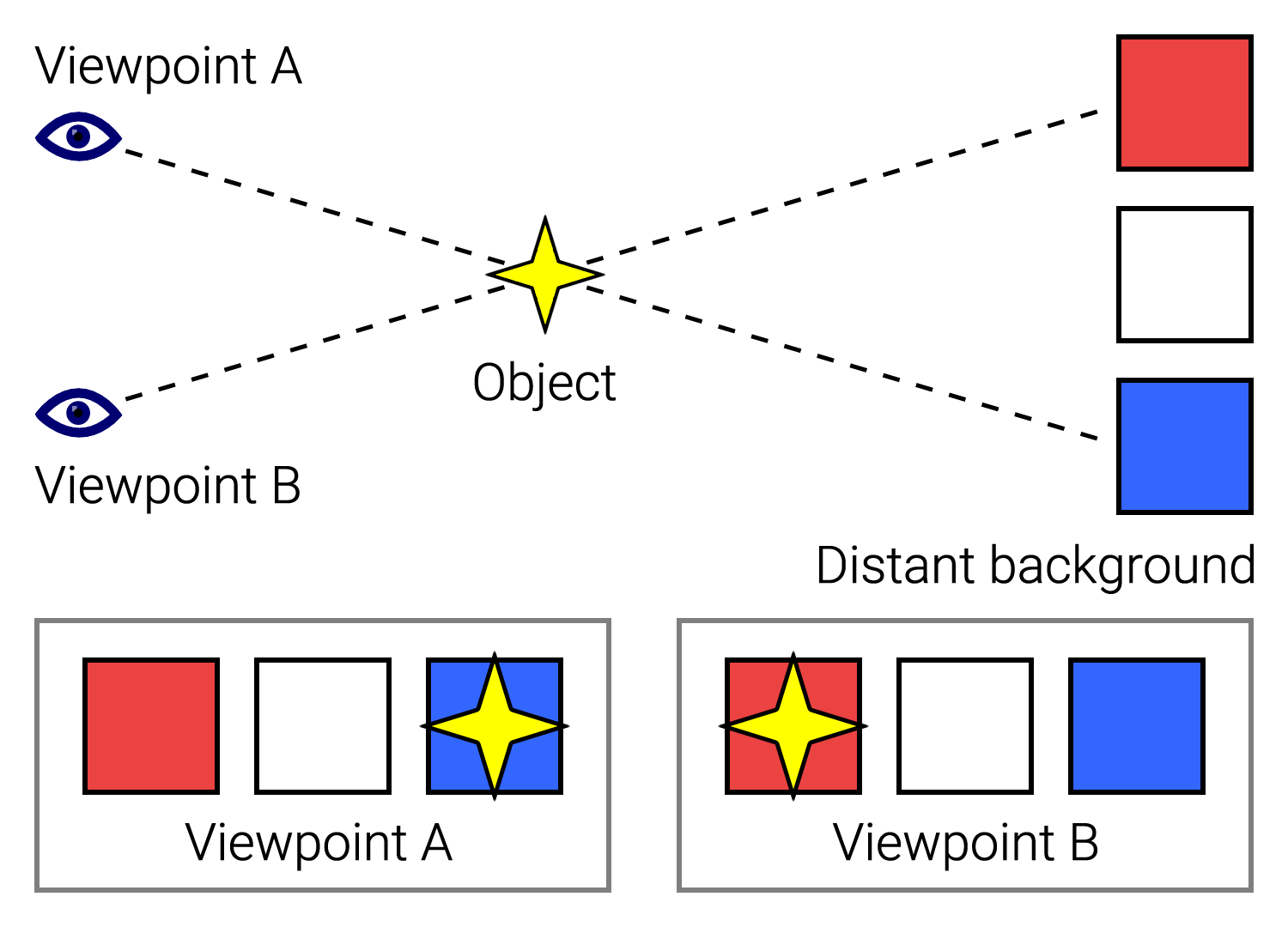
Why didn’t the Greeks see parallax due to the Earth orbiting around the sun?
The distances are far too large to see parallax.
What is the geocentric model?
Earth as the stationary center of the universe, with the Sun, Moon, stars, and planets orbiting it.
What disproves the geocentric model?
Galileo discovered moons around Jupiter that orbit around jupiter, phases of Venus (if Venus in different areas of the sun, it looks darker or lighter, suggests that it orbits the sun).
Giovanni Zupi saw phases of Mercury.

What is heliocentrism?
Each planet was imagined to move on a small circle (the epicycle), whose center of the smaller circle moved along a larger circle (the deferent) centered on the Earth.
Heliocentrism simplified this model, but suggesting that planets moved on elliptical orbits. Isaac Newton gravity explains elliptical orbits.
What is stellar aberration?
Stellar aberration is the apparent shift in the position of a star due to the motion of the observer (Earth) as it moves through space.
If we were standing still in space, we wouldn’t see this effect. But because Earth is always moving at about 30 km/s, we experience this small shift in star positions over the course of a year. (if you look in telescope in jan it will be different than in apr).
Disproved geocentrism.
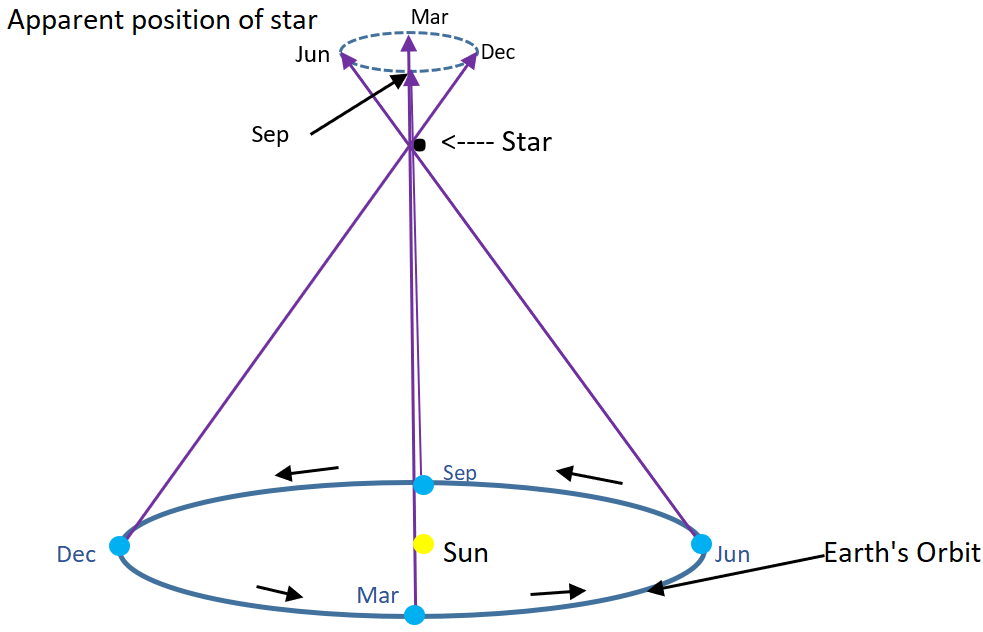
Why was the stellar aberration hard to observe?
The size of the stellar aberration was 20 arcseconds, where there are 3600 arcseconds per degree.
Early telescopes lacked the precision to detect such a small change easily.
How big is the observable universe?
1026m
We don;t know how big the Universe is, we can only say big the bit we see is.
What is the theory of general relativity?
Massive objects (like the Sun) bend the fabric of spacetime, and this curvature tells objects how to move.
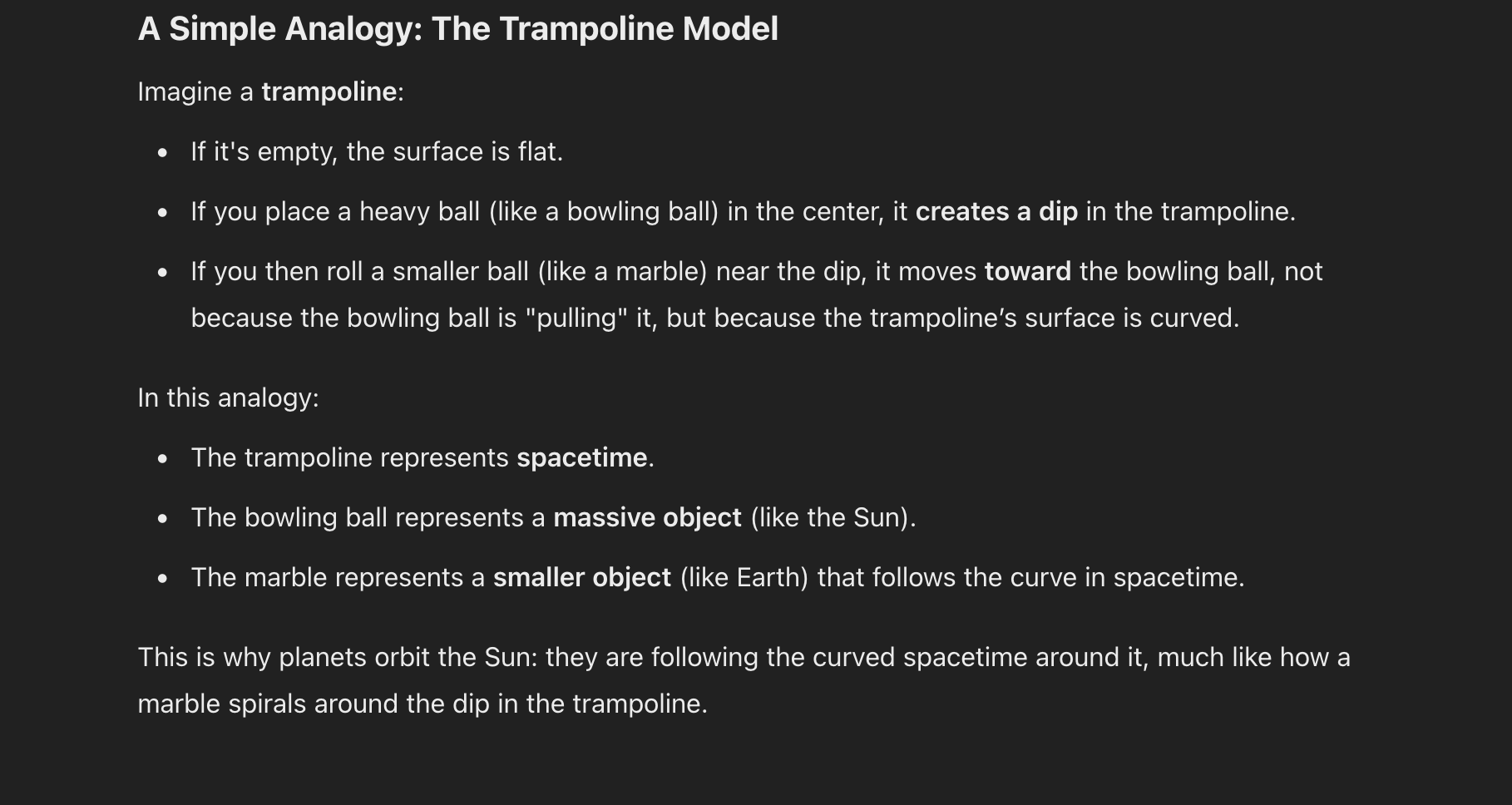
What is “standard" candle”?
If you see a candle, you can estimate it’s distance based on brightness.
This suggests that stars found in the sky are much further away than expecterd.
What are nebulae?
They are clouds in the galaxy.
What is a spectrograph?
Instrument to measure intensity as a function of wavelength.
What was the first evidence that the universe is expanding?
Via spectrographs, it was found that everything was moving away from us, and further away objects move faster.
What is the cosmic address?
Earth, solar system, milky way galaxy, local group of galaxies, local supercluster, cosmic web.
What are the three key features of the big bang model?
Homogeneous.
Expanding.
Very hot and dense at early times.
Describe homogeneous in cosmology.
If we teleport anywhere in the Universe, the Universe will look the same statistically.
On average, the Universe is the same everywhere.
What is the implication of an expanding universe?
There is a beginning.
And either:
-we are at the center of the universe
-or everything is moving apart.
What is a cosmology redshift?
A cosmological redshift is the stretching of light waves from distant galaxies due to the expansion of the universe.
When a galaxy emits light, that light travels across space toward us. But — space itself is expanding over time, and as the light travels through that expanding space, its wavelength gets stretched.
This stretching shifts the light toward the redder (longer wavelength) end of the electromagnetic spectrum. Hence, it's called redshift.
What happens to objects in the universe?
Whilst the universe is expanding, objects do not expand.
How do we know that the early universe was hot and dense?
The fact that galaxies are moving away from us (redshift) suggests the universe is expanding.
If we rewind time, that means the universe must have been smaller, denser, and hotter in the past.
The CMB is faint, uniform radiation that fills the universe and is a direct remnant of the early hot universe.
Its spectrum matches that of a perfect blackbody, which is exactly what we expect from a dense, hot thermal environment.
What is the cosmic microwave background?
The CMB is the faint glow of radiation left over from the early universe. It is the oldest light we can observe, dating back to about 380,000 years after the Big Bang, when the universe first became transparent to radiation.
In the very early universe, everything was super hot and dense, in the form of plasma. In the plasma, light couldn’t travel far because it kept bouncing off electrons.
As the universe expaned, it cooled down enough for electrons and protons combined to form hydrogen atoms (recombination). This allowed photons to move freely, emitting light.
It cools down over time.
What are the contents of the universe?
Ordinary or baryonic matter, stuff we see on earth.
Dark matter, which behaves like ordinary matter, but we cannot see.
Dark energy, which doesn’t behave like ordinary matter, and we cannot see.
What is evidence for dark matter?
When astronomers measure how fast stars orbit around galaxies, they expect stars farther out to move slower, like planets in the solar system.
But instead, stars in galaxies orbit at roughly the same speed, even far from the center—too fast for the visible mass alone to hold them.
This suggests there's extra unseen mass—aka dark matter—surrounding galaxies in massive halos.
What is the gravitational cascade?
Starts small with tiny gravitational pulls towards slightly denser regions, but it increases with time, as more mass falls into dense areas, which increases the gravitational attraction.
The slope gets steeper with time.
With time, this gravitational collapse becomes a runaway process. In regions of very high density, galaxies and stars are formed.
THis is how galaxies and clusters of galaxies form.
A space was initially fairly homogenous, but at the end state, it becomes very clumpy.
How is a star formed?
Stars begin in giant clouds of gas and dust, called nebulae. Something triggers part of the cloud to collapse
These clouds are mostly made of hydrogen and helium, but is contaminated by heavier elements formed in supernovae explosions.
As clouds collapse, its spin increases, and a dense object forms at its core.
The collapse heats the gas.
If the density and temperature at the centre of the cloud becomes high enough, thermonuclear burning or fusion will start, forming a star.
If a runaway gravitational cascade is how we make objects, why aren't there more black holes?
Gravitational cascade must be a perfect sphere with no rotation
What is a star?
A hot ball of gas.
The more massive the star, the hotter itshines.
What is Blackbody spectra (radiation)?
A blackbody can absorb all light, and is capable of emitting thermal radiation (heat).
The colour of the light that is emitted is contingent on its temperature.
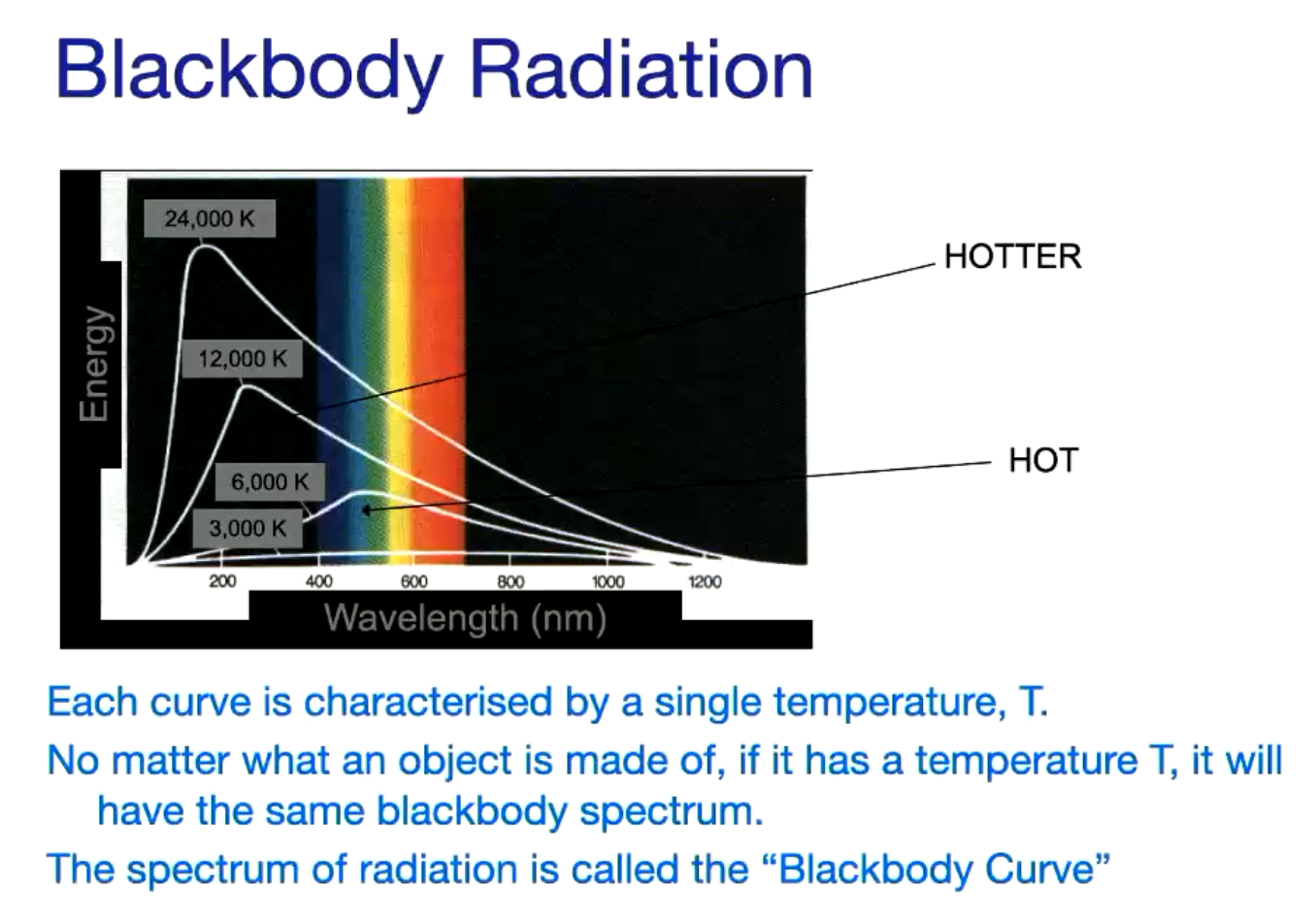
What is the Hertzsprung-Russell diagram?
A plot of luminosity (brightness of star) against temperature for each star.
White dwarfs are small stars (high temp, but not bright).
Giants/super giants are large (same logic).
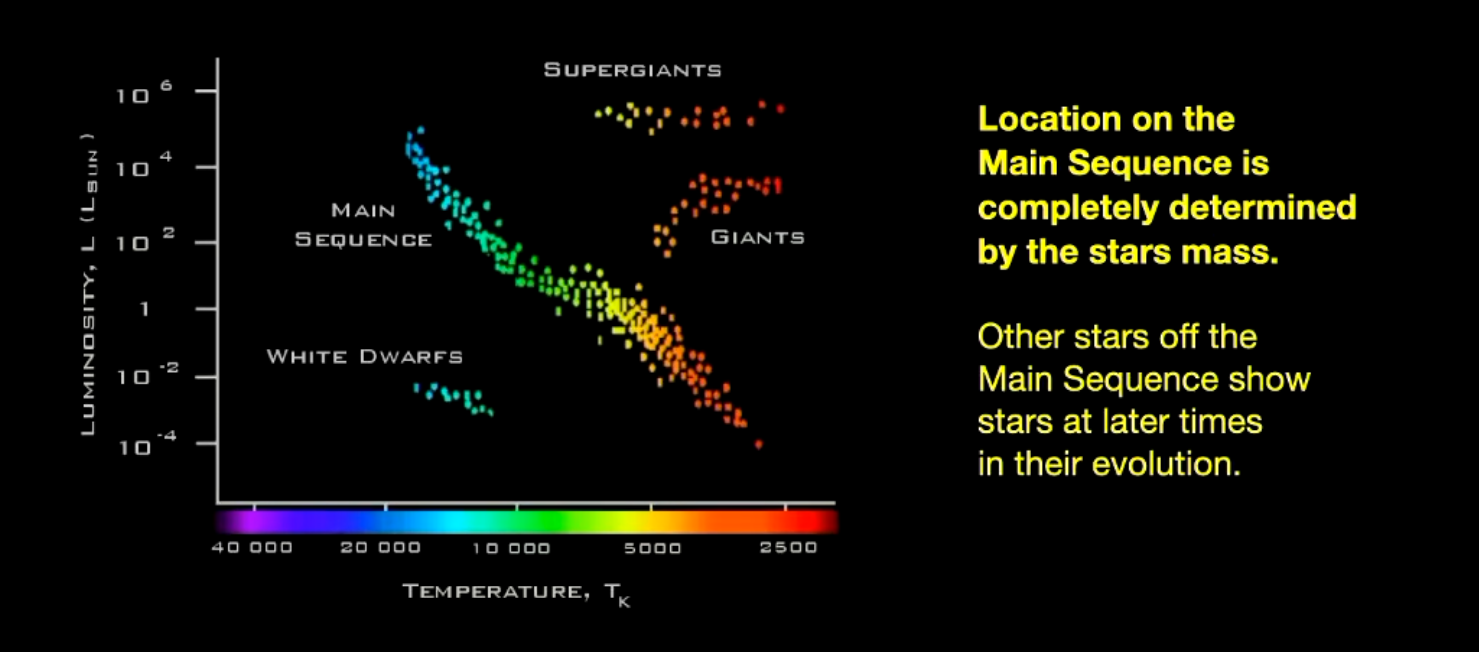
Describe stellar evolution.
Bright stars burn very brightly, but do not last as long.
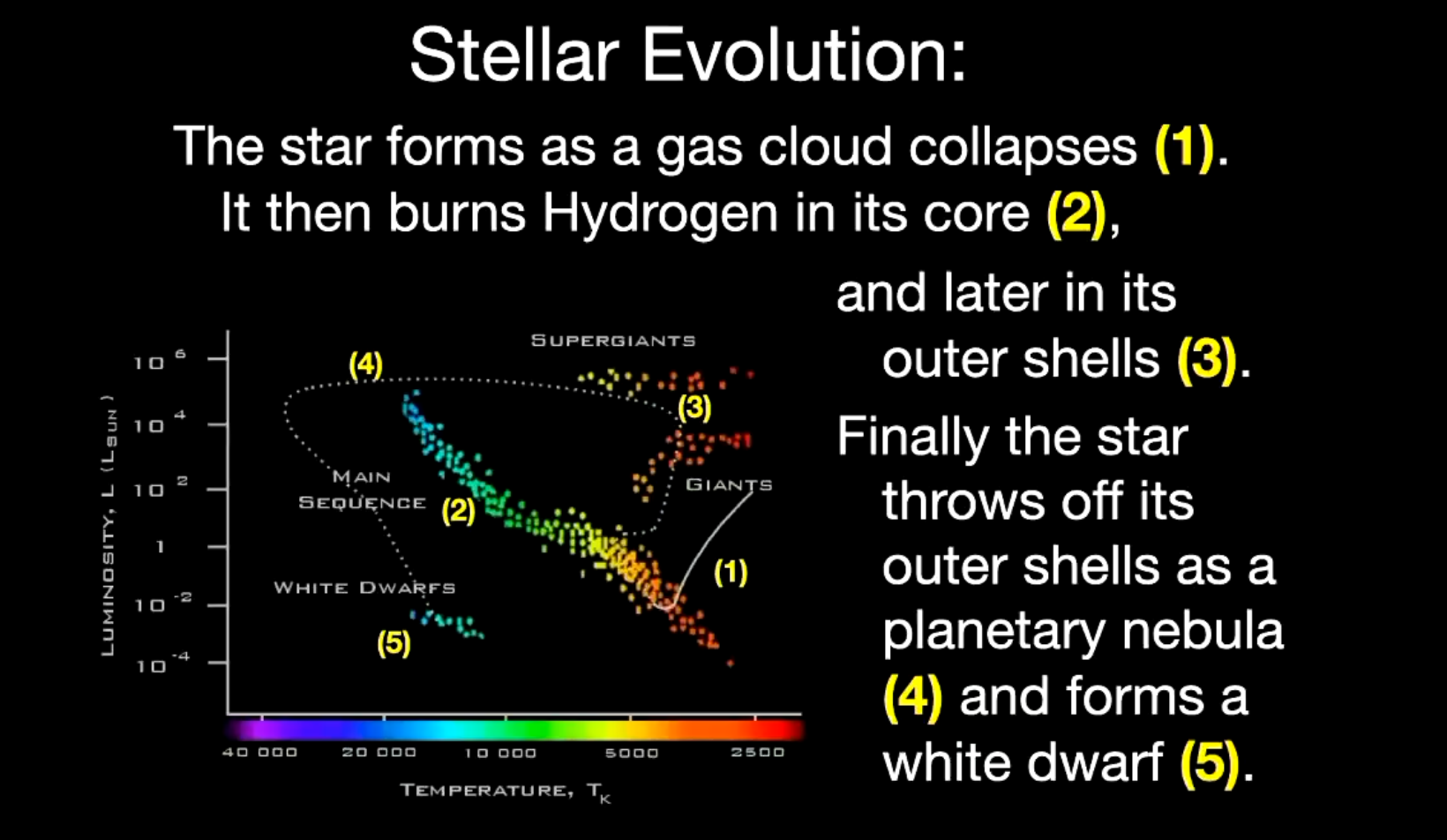
Describe star death of small star.
The endpoint of a star depends on the stars mass/
Low mass stars burn all their hydrogen fuel, forming red giants.
The core collapses into a white dwarf, while the outskirts are blown off as a planetary nebula.
Red giant → planetary nebula → white dwarf.
What are red giants?
They are big and relatively cold.
The expand because fusion is happening closer to the surface.
They begin to lost mass.
What are planetary nebula?
Illuminated gas clouds.
What is a white dwarf?
Hot ember of degenerate matter, which cools with time.
Describe star death of large star.
High mass stars burn all their hydrogen, and then progressively burn heavier elements until they reach iron.
The final collapse and burning is fast and furious: the star forms a super-heavy core, while the remaining gas is blown off as a supernova.
The super-heavy core can either be a neutron star or, if the original star is heavier, a black hole.
What will happen to the Earth when the Sun dies?
It will either be burnt up by the outer regions of the red giant or spiral outwards as the sun loses mass, hot but will remain a planet.
What is a neutron star?
A degenerate star made of tightly packed neutrons.
They are usually observed as pulsars which are rotating on their axes about once a second, emitting beams of radiation.
Neutron star matter is the most extreme form of matter known.
To study neutron stars,you look at the form and behavior of pulsars.
What is a blak hole?
A region of space with such a high density that not even light can escape.

What does a supernova spew out?
Each supernova spews new elements out to provide the gas for the next generation of stars and planets.
What is a wave?
Waves are regular oscillation.
Many subtypes:
pressure and density waves (sound)
displacement waves (vibrating string)
surface waves (some ocean waves)
electromagnetic (light)
gravitational
Bolded do not involve the movement of particles,
What is the old definition of light (classical wave theory)?
Light is an electromagnetic wave.
Has electric and magnetic field, perpendicular to each other and direction of motion.
speed=wavelength*frequency=frequency/period
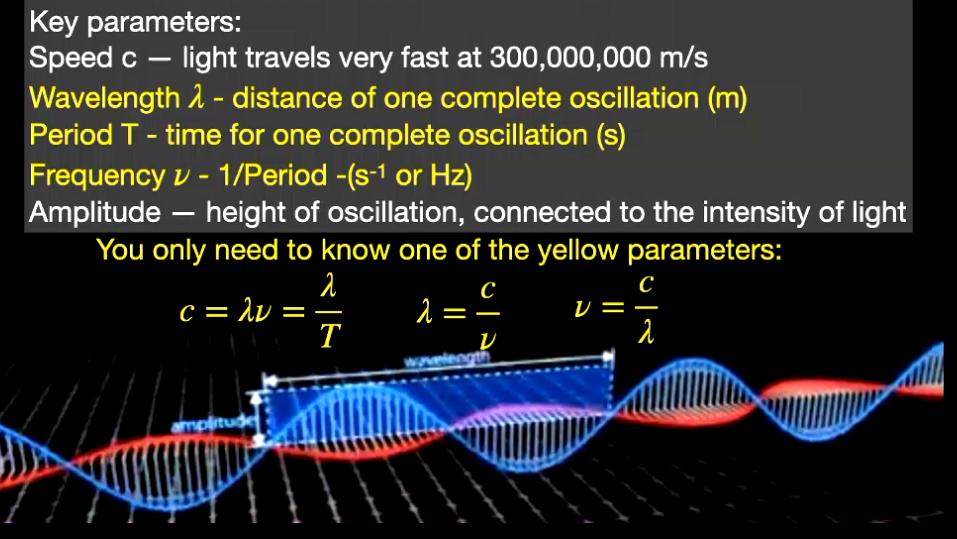
What is the issue with the old definition of light in terms of atoms existing?

What is the issue with the old definition of light in terms of the photoelectric effect and photosynthesis?
In photosynthesis, light energy is absorbed by pigments (Cl A & B and Carotenoids) and converted to chemical energy. Classical physics states that light energy is a continuous wave, thus even if there is a very weak light, if given enough time, should build up energy in the molecule and trigger a chemical reaction.
Photosynthesis only occurs when light above a certain frequency (color) is used — regardless of brightness.
Weak red light doesn't work.
Only higher-frequency (e.g., blue or violet) photons can excite the electrons needed to start the reaction.
According to classical physics, light is a continuous wave, and the energy it transfers depends on its intensity (brightness) not its frequency (colour). Thus, any freq of light, if intense enough should eject electrons from a metal surface, and more intense light should cause more energetic electrons to be ejected. Also there may be a delay, as electrons must absorb energy.
However,
-No electrons were emitted if the lights frequency was below a certain threshold.
The energy of ejected electrons depended on the frequency of light, not its intensity.
Electrons were emitted instantly, with no delay, even at very low light intensities, as long as frequency was above the threshold.
What is the modern definition of light?
Light is made up of photons, which have characteristics which are both wave and particle like.
Each photon has a wavelength and an energy.
What are the basic sequences of photons?
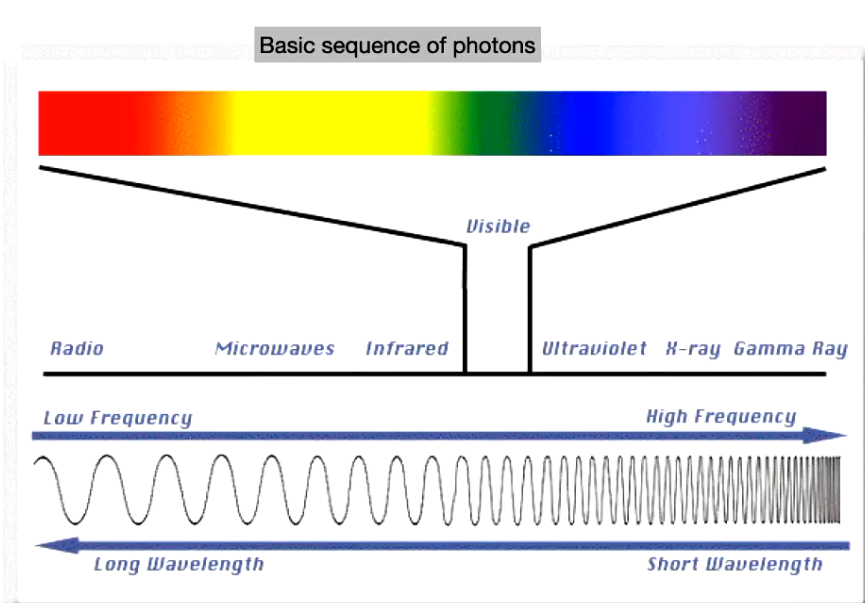
Why is the ‘visible’ light where it is?
The peak intensity of the sun is in the visible range.
Our eyes have evolved to be sensitive to that part of the spectrum.
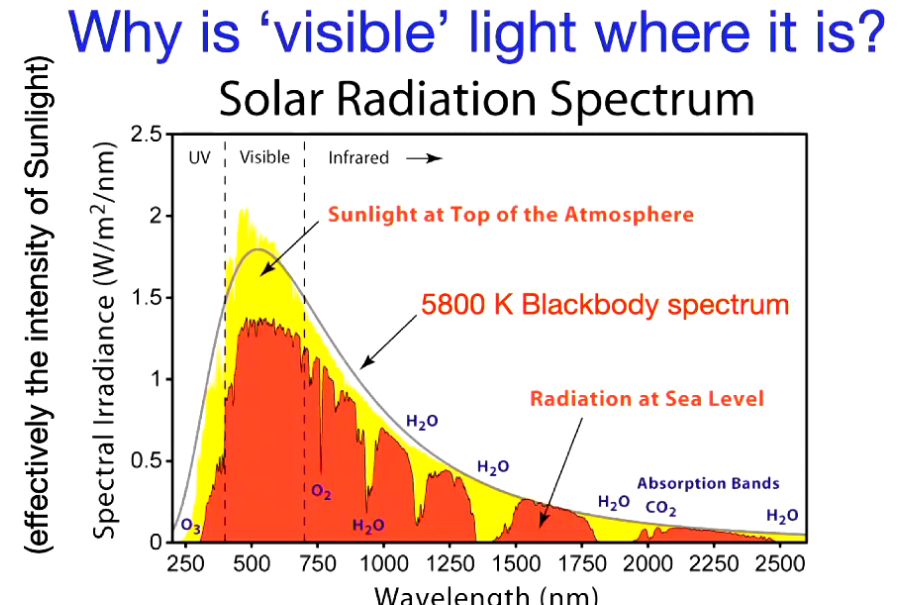
What are nuclear reactions?
Reaction that change elements.
Nuclear reactions only take place at very high density, pressure and temperature.
You can find these conditions in the very early universe, a few seconds to minutes after the ‘Big Bang’.
In stars.
How did the early universe lead to the generation of elements?
The early universe was very hot, dense, and small.
This allowed for nuclear reactions to take place.
As the universe expanded a bit, energy turned into matter. This allowed for protons and neutrons to fuse and form: hydrogen, helium and other elements. Eletrons couldn’t bind to these nuclei, as it was too hot - just nuclei, electrons and photons in a plasma soup.
380,000 years later, it cooled enough for electrons to join nuclei. This is CMB.
It is now too cold for nuclear reactions to take place.
During the big bang nucleosynthesis, where H and He was formed, why were only these elements formed?
Only these elements formed as the probability of more particles colliding at the same time, is highly unlikely.
How did other elements form after the big bang nucleosynthesis event?
Once stars form, the core of these stars become very hot and dense enough for nuclear fusion to occur.
H→He→C and O 9in red giants) C→ Ne→Mg→Si→Fe (in massive stars)
Supernova nucleosynthesis: when massive stars run out of fuel, they produce a supernova. The huge burst of energy is extreme enough to fuse iron into heavier elements.
When two neutron stars merge, it creates lots of heavy elements.
Cosmic ray spallation.
What are cosmic rays?
Cosmic rays are particles traveling through space near the speed of light.
Cosmic ray spallation: high speed cosmic ray strikes an object and sends a spray of light nucleons.
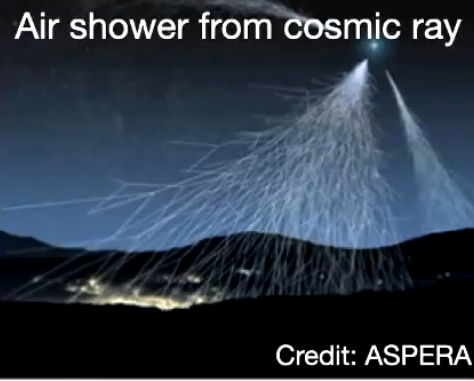
How do we get elements out the star?
Supernovae sprinkle the galaxy with the metals created inside the star.
All stars lose some material over time through stellar winds — streams of particles blown away from the surface.
What happens after a white dwarf forms?
It cools to absolute zero over 10s or 100s of billions of years, leaving an invisible “black dwarf”.
What is the solar nebular hypothesis?
A giant molecular cloud (nebula) collapsed due to a nearby supernova.
Most of the material fell inward to form the sun.
The remaining formed a flat disk. The spin of this disk increased, making it more dense and hot. Once the disk reaches a stable configuration, grains (dust and gas) began sticking to the disk, forming planetsimals, where these planetesimals could come together and form planets.
Closer to the sun, terrestrial planets, far away, jovian.
Once the sun turned on, it cleared out the remaining dust and gas.
The cloud was enriched with elements which only form in supernova explosions of massive stars.
What do you observe in the Solar System?
All planets orbit the Sun. Most planets rotate in the same direction as they revolve around the Sun (except Venus and Uranus).
The sun has 99.9% of the mass and the planets have 99.7% of the angular momentum.
The inner terrestrial planets are sma;ll and dense and are composed of silicates and metals.
The outer jovian planets are large and massive, with the same composition as the Sun (H and He). They are rich in ices and volatiles.
All giant planets have regular moon systems.
Lots of leftover junk in the solar system: asteroids and comets.
What is the sequence of formation of the Solar system?
A large weakly rotating cloud of gas collapses.
Most of the mass collects at the centre, forming the sun. When it is hot enough at the centre, the Sun turns on.
The rest of the clouds form a disk, which increases its spin, flattens, heats up and becomes more dense.
Once the disk reaches a stable configuration, it begins to cool. Solid grains start to stick together to form larger grains and so on, eventually building a planetsimals.
Once planetesimals are big enough, they start to gravitationally attract each other and dust, thereby adding mass to grow into planets.
-The inner regions are mostly composed of iron nickel and silicon.
-The outer regions, cooler regions, contain lighter elements, such as H and He.
if planets are closer to the sun, they contain rocks and metals. Where if they are further away, mostly hydrogen and helium.
When the sun turned on, solar winds cleared out the remaining gas and dust.
What happened to the leftover junk from the sun turning on?
In the outer solar system, the small icy objects are comets, plus some larger dwarf planets.
The inner solar system contain asteroids.
In the outer regions past neptune, the disk wasn’t dense enough to form new planets. May be up to 100 dwarf planets.
What are comets?
Small icy bodies leftover from the formation of the jovian planets.
Comets near jovian planets were either deflected into the inner Solar System, to evaporate near the Sun;
Or they were deflected to the edges of of the Solar System to the Oort Cloud or Kuiper Belt, where they remain in cold storage.
What are dwarf planets?
Big enough to be ‘round;
Orbit the sun.
Too small to clear their orbital neighbourhood (a lot of stuff around the dwarf planets).
How was the moon formed?
A body, bigger than Mars, hit the Earth about 50 my after its formation.
Earth was almost shattered; lots of material ejected to form an orbiting debris field around the Earth; the ring of debris quickly condensed to form a single body, the Moon.
Why is the moon important for the evolution of life?
The moon stabilised Earth’s rotation axis, assisting in stabilising Earth’s climate.
The moons gravity causes ocean tides, helping to circulate nutrients in marine environments.
Helped slow down the rotation of Earth, stabilising temperatures.
What are the terrestrial planets? Key prop
Mercury, Venus, Earth, and Mars.
Composition: earth like - rocks and metals.
Size: comparable to earth.
Location: close to the sun, thus warm to hot.
Atmosphere is present on earth and Venus, traces on mars.
Moons: Very few. Our Moon and Deimos and Phobos around Mars.
Describe Mercury, Mars and Venus.
Mercury: barren hot rock.
Venus: similar to Earth, but with 70x atmosphere- runaway greenhouse. Orbits backwards.
Mars: next most hospitable planet.
What are the Jovian planets? Key properties?
Jupiter, Saturn, Uranus and Neptune.
Composition: sun-like - hydrogen, helium and trace amounts o other stuff.
Size: big. 14-320x earth.
Location: far from the sun, thus cold.
Atmosphere: gaseous, no surface.
Moons: Many. Hundreds altogether in a minature solar system.
Describe Jupiter, Saturn, Uranus and Neptune. Possibility of life?
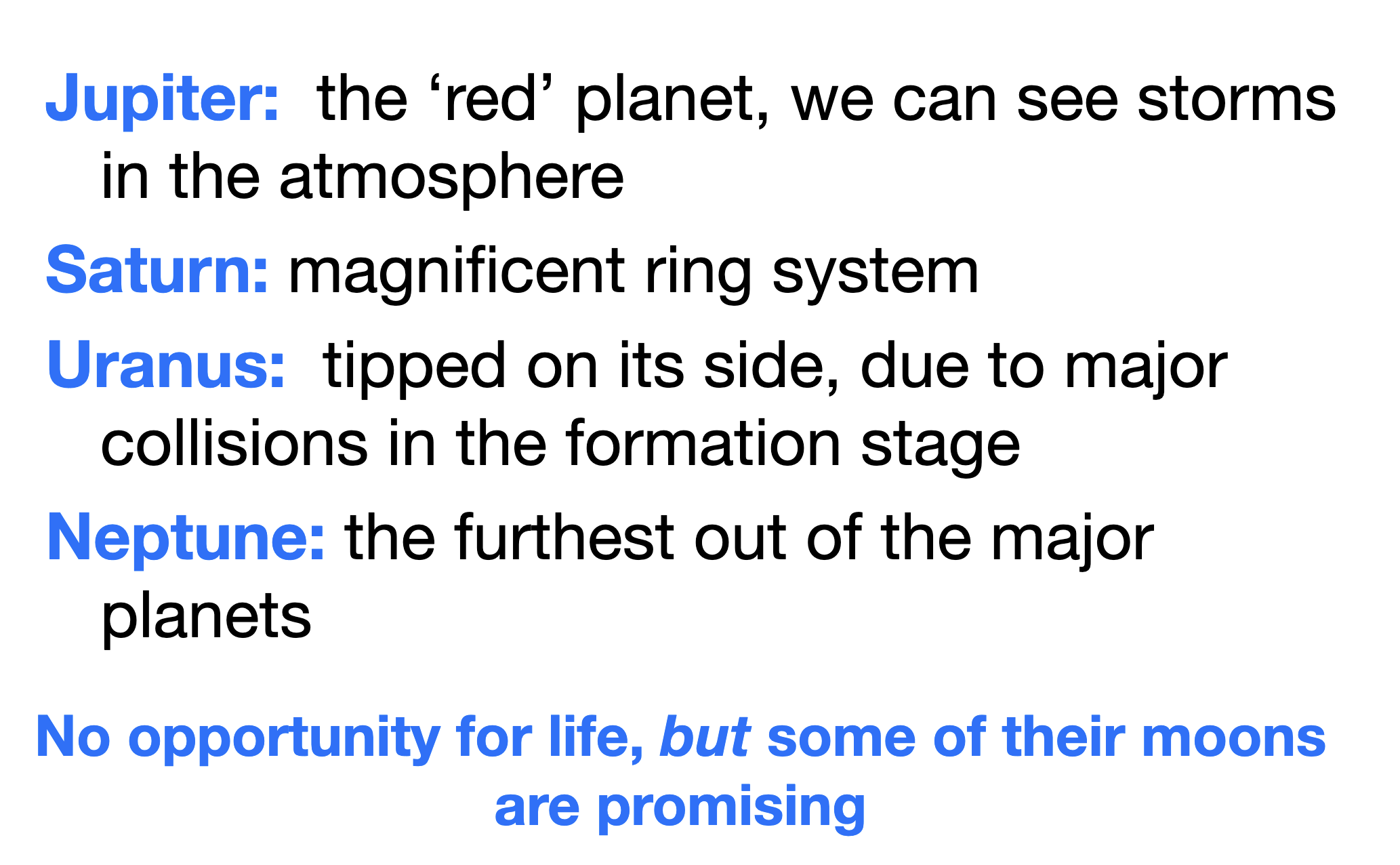
Why wouldn’t you find life on Jovian planets?
Lack of building blocks of life. Mostly H and He.
What is Kepler’s Law of Harmonies?
The further away we are from the sun, the longer the orbital period.
distance of sun³ is proportional to orbital period²
What are the factors that determine if a planet will hold onto a molecule in its atmosphere?
The temperature of the gas.
The gravitational field at the surface.
What is escape velocity? What is it on Earth?
Escape velocity is the minimum speed an object must have to break free from the gravitational pull of a planet, moon, or other body without further propulsion.
The escape velocity is 11km/sec for earth.
It doesn’t matter if it’s a rocked or a molecule, the velocity is the same.
How does gravity determine if a planet will hold onto a molecule in its atmosphere?
It determines the velocity required to escape.
THis is higher for more massive or denser planets.
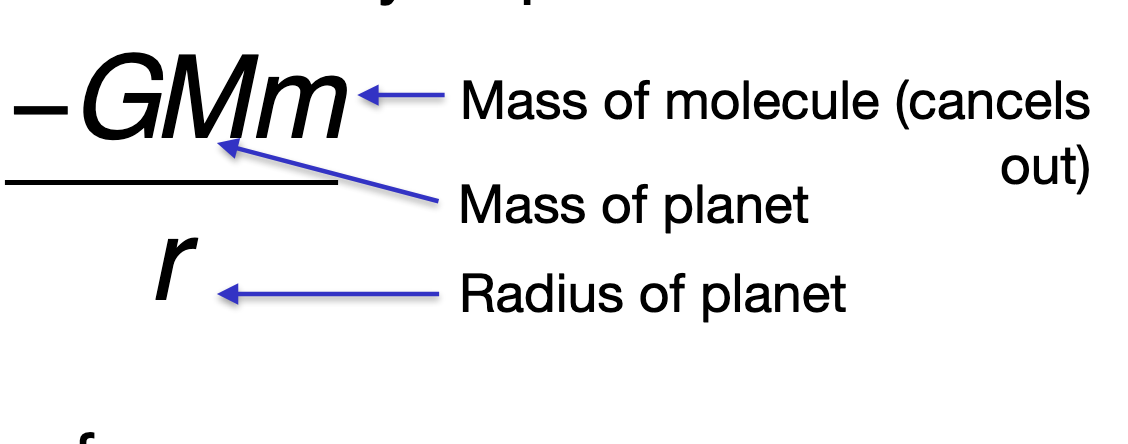
How does temperature determine if a planet will hold onto a molecule in its atmosphere?
At a fixed temperature, lighter molecules have a higher velocity; heavier
molecules have a lower velocity.
The kinetic energy and velocity increases with temperature.
This means that small, hot planet cannot keep light molecules, like H, but can keep heavier ones like CO2. Big, cool planets like Jupiter keep everything from hydrogen.
How do we get an atmosphere? Or lose it.
Outgassing from rocky interiors i.e. volcanoes.
Comet impacts.
Formation of the planet (like Jupiter).
You can lose an atmosphere by it escaping into space and by chemical reactions with rocks.
What hits Earth?
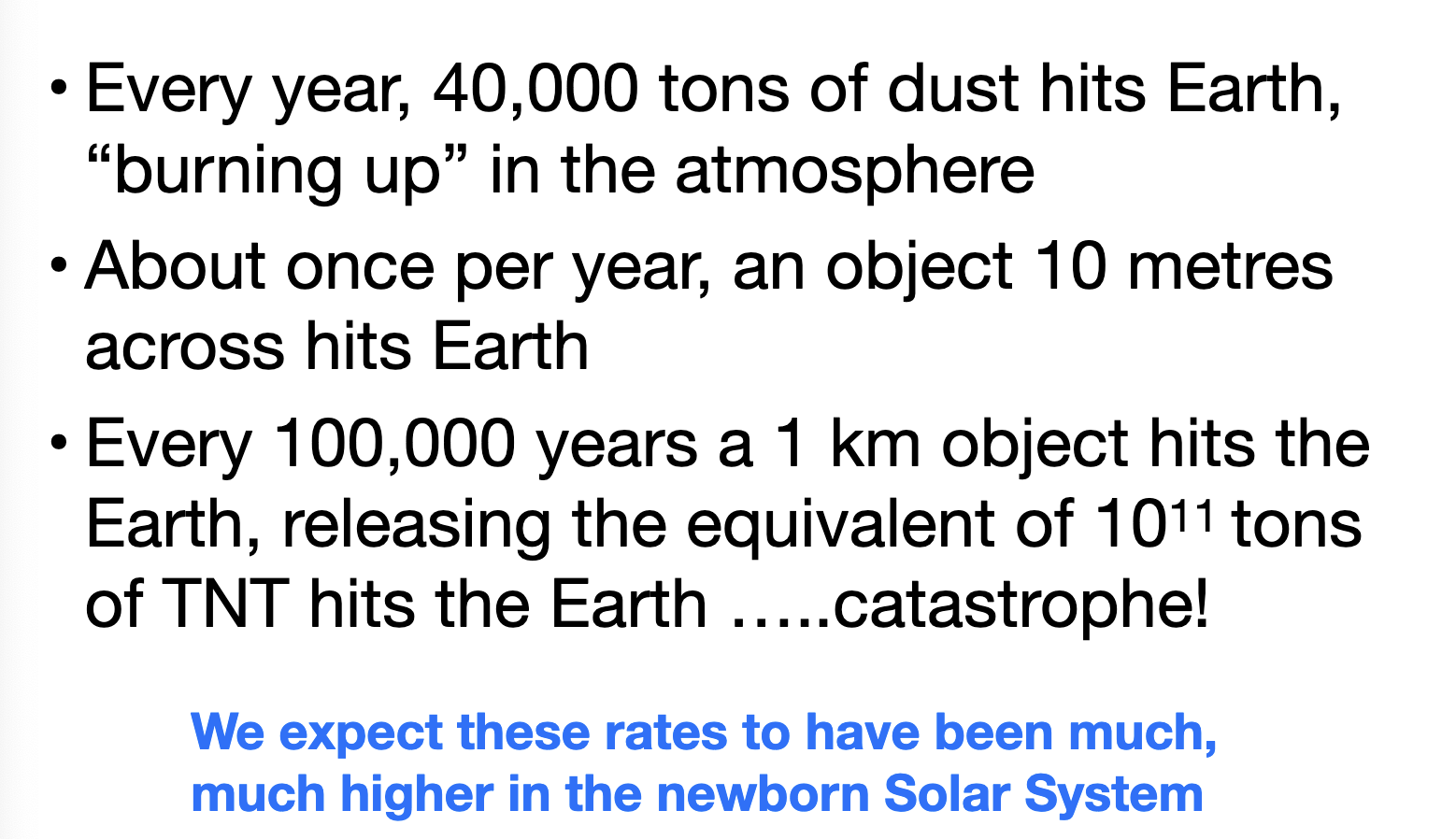
How did Earth get watere?
Outgassing (mostly from volcanic action).
Accumulated impacts by icy comets.
What are the general recipes for a home for life?
• Heavy elements: eg O, C, H, N, P, S
• A protective shield: atmosphere or liquid
• Energy source, probably a star (like the sun)
• Liquid water, or suitable substitute
• Stability
• A liquid/solid surface?
• A moon?
Why do we need water for life?
Water has:
-large temperature range for liquid
-relatively warm liquid range (generates life efficiently, too cold life generates slow, too fast life can’t live)
-solid form is less dense and floats
-a polar molecule, meaning it can dissolve polarized molecules, but not unpolarised ones, so it si good for cell architecture.
Can life exist on Europa (moon on jupiter)? What is the other moon that also shows potentail life?
Frozen moon.
Hydrogen peroxide (H2O2) is “abundant” on Europa’s surface.
• Hydrogen Peroxide is highly oxidising and decays to O2 when mixed with water.
• This could provide the chemical energy source for life forms on Europa
Look for bacteria in plumes.
Enceladus, also a frozen moon on Jupiter, can also house life. There were organic molecules detected in the depths of Enceladus.
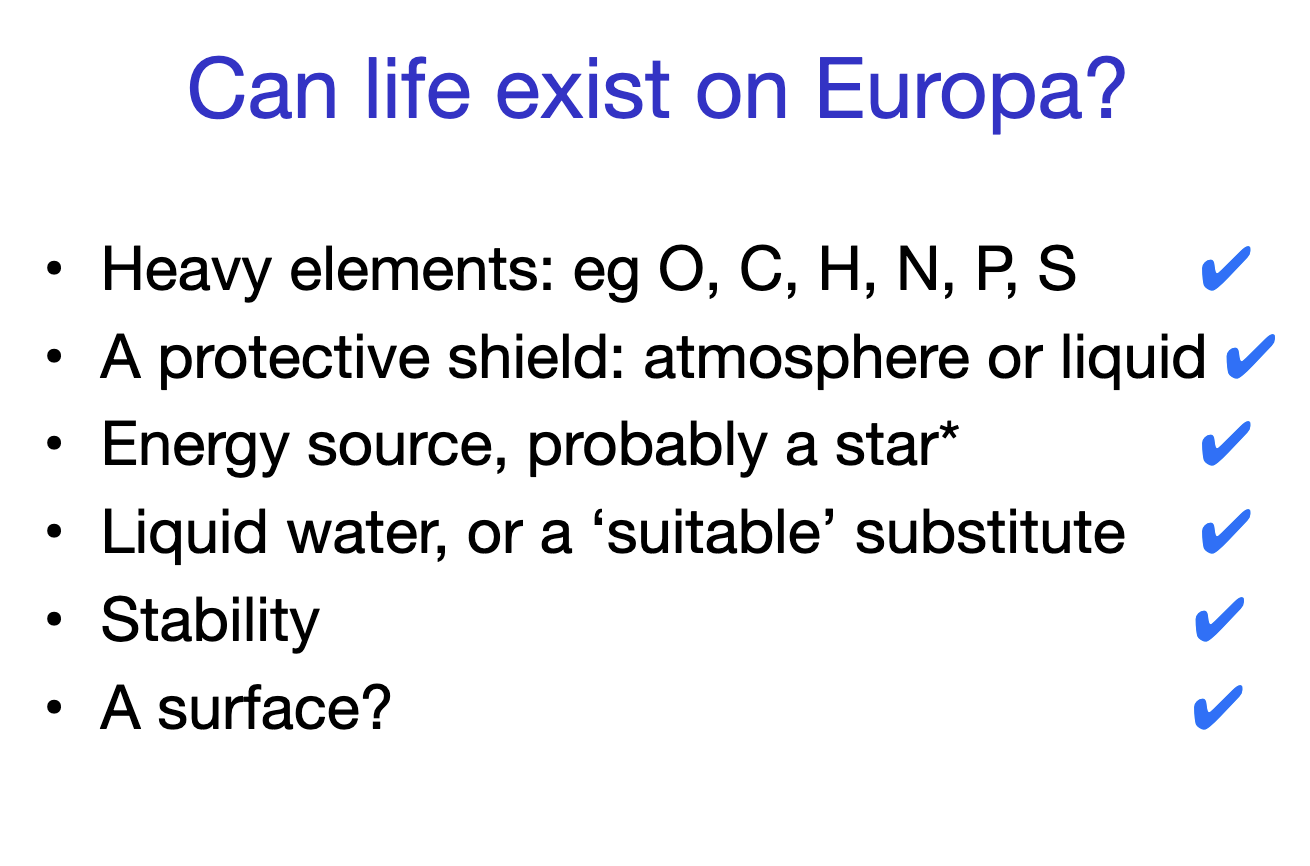
How do you find water on the moon?
Creating man made plumes by hitting the moon very hard, potentially releasing water.
Detect the spectral signature of OH/H2O everywhere on the lunar surface.
Suggests OH produced by solar wind.
Other analyses argued water was only stable at high latitudes, and varied with the lunar day towards the equator. This might mean that the water molecules hop around till trapped in a local cold spot (the poles or a shaded crater).
• Accessible water would be useful for drinking and rocket fuel. A shallow coating of the highly reactive OH is hard to mine.
Moon has no atmosphere, thus no life.
Describe the surface of Mars and its viability for life.
Arid, cratered, little atmosphere, no magnetic field to protect from cosmic rays, no oxygen.
Mars has seasons due to the tilt of its axis, similar to earth (25º vs earth’s 23.5º).
Mars has polar ice caps which grow and shrink with the seasons, where these ice caps have a combination fo water ice and CO2 ice.
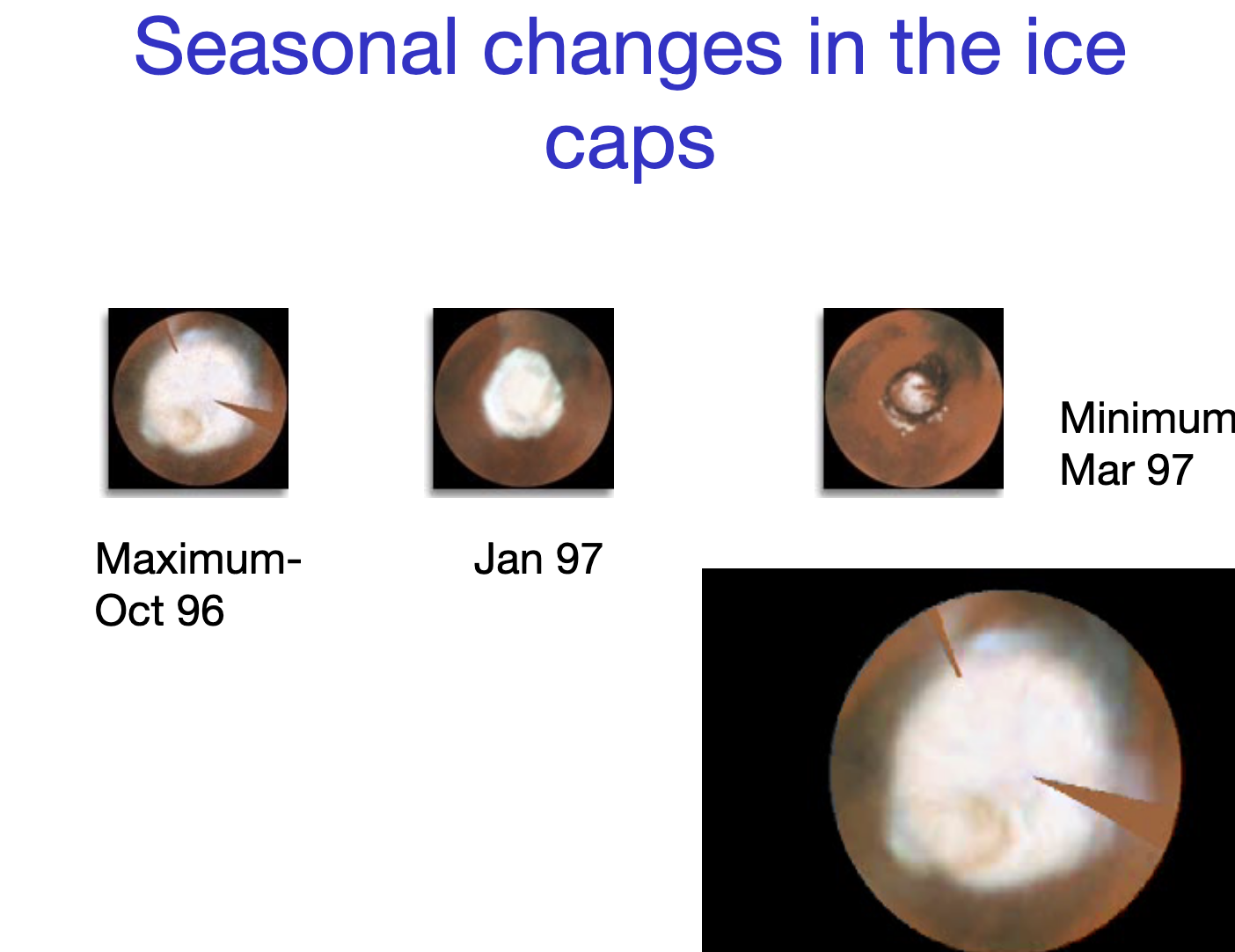
What was the evidence for past water on Mars?
Surface channels that look like dry river beds, 2-3 byo.
Martian landers and rovers found minerals which form only in water.
THe source of water is unclear, potentially due to volcanic outgassing.
Is Mars suitable for microbial life?
In 2013, via samples.
Ancient network of rivers and lakes made Mars a suitable home for microbial life.
Discovered clay minerals that could only have formed in water, along with other atoms required for life.
However, the surface of Mars is bombarded by radiation
-no magnetic field and very little atmosphere.
Radiation comes from solar wind and cosmic rays.
THUS, life (if any) would need to be underground (likely several metre under).
How does gravity work?
Two objects exert a gravitational force on each other (which is equal and opposite).
If the objects have sufficient velocity perpendicular to the line joining them, they will orbit one another.
The orbits of the two objects are stable in time.
What happens if one object is much more massive than the other, in terms of orbit?
If we sit on the massive object (sun)
-the small object will orbit in an ellipse.
-the radius of the ellipse a is related to the period P by a3 relational to P2
The heavy star moves a little, but a small planet moves a lot.
What are methods for finding planets?
Doppler method.
Astrometry.
Transit.
Gravitational lensing.
Pulsars.
Direct imaging.
What is the Doppler method?
Light from moving object is redshifted or blueshifted.
Doppler shift is when the light from a moving object is compressed (moving towards you) or stretched (moving away).
Only works if stars spectrum has some identifiable features.
What is astrometry?
Astrometry can be used to find exoplanets by detecting the tiny movements (wobbles) caused by the gravitational pull of an orbiting planet.
Requires ultra precise position measurements.
Which orbital orientation is good for astrometry and Doppler shift?
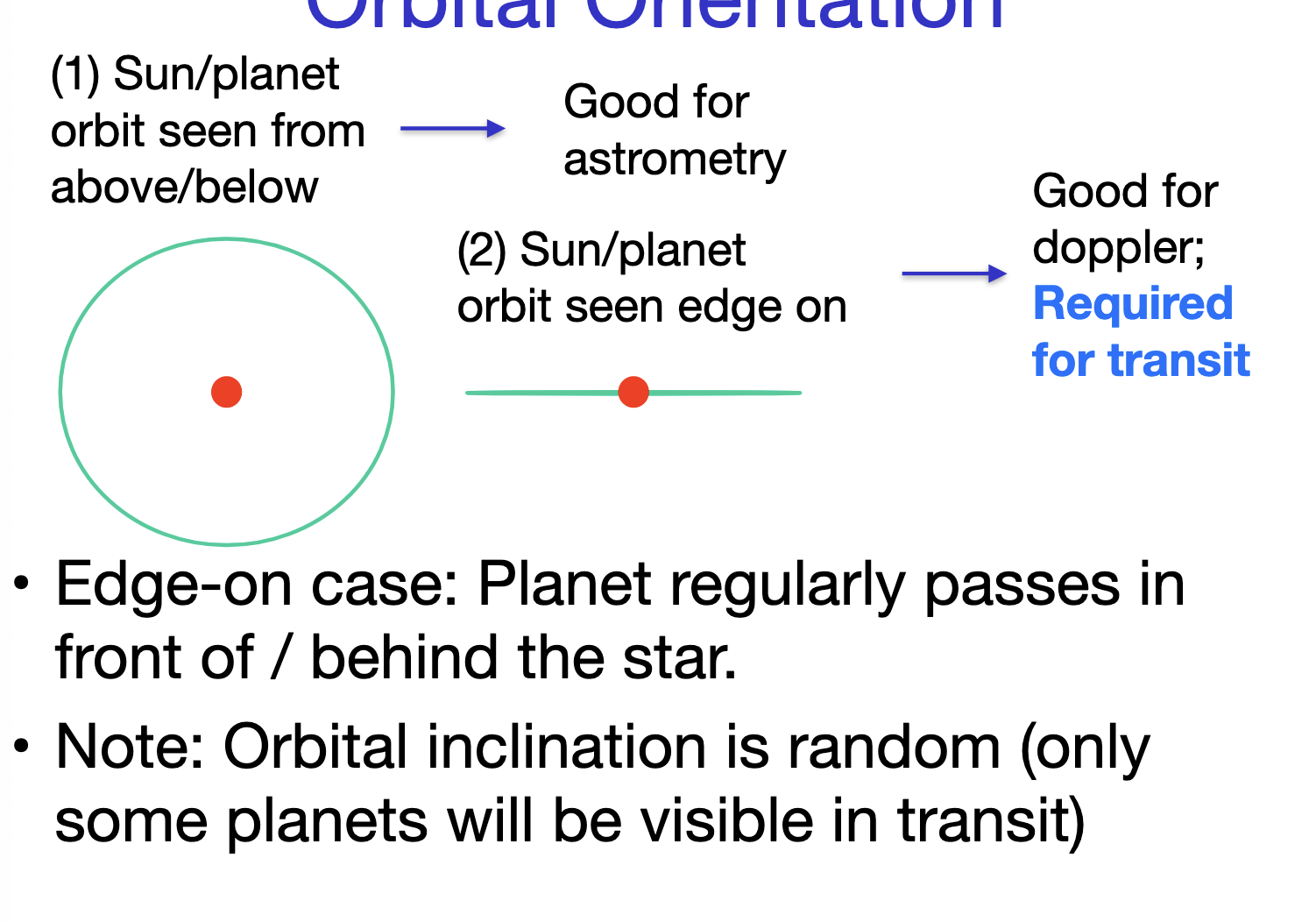
What is transits? What can it measure?
Since the planet is much fainter than the star, it will block some of the light from the star, and generate a characteristic signature.
period
• planets mass & orbital
radius
• planet’s radius, hence its density.
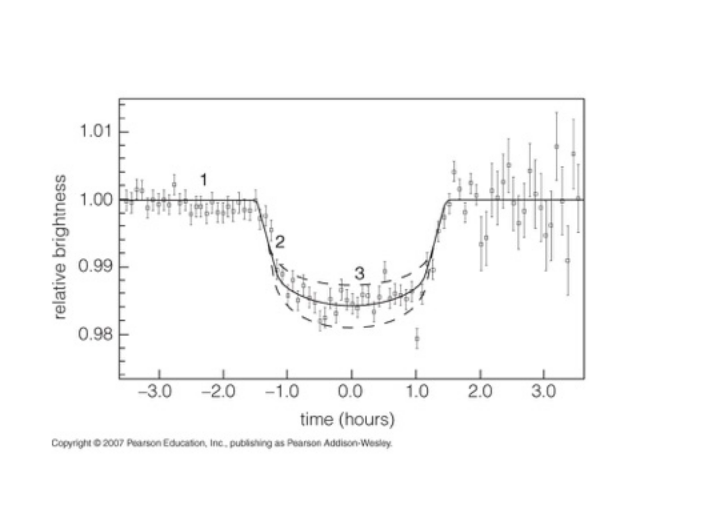
What would lead to a fractinally bigger dip in the lightcurve during transit?
a. making the orbit more eliptical
b. making the planet smaller
c. making the star smaller
C.
What are pulsar planets?
Pulsars (type of neutron star???) are perhaps the best clocks known; its easy to measure their Doppler shift.
Almost certainly a terrible place for life, since the pulsar has already gone supernova.
What is direct imaging?
It is hard to take a direct picture fo a planet as
-it is a billion times fainter (optical) or 100,000 times (infared) thant he star.
- it is very close to the star and difficult to resolve.
What kinds of stars might support living planets?
Two factors of stars influence whether a planet has life:
-energy source: star in its hydrogen-burning phase (main sequence).
-stable.
Practically all of them (except the most massive).
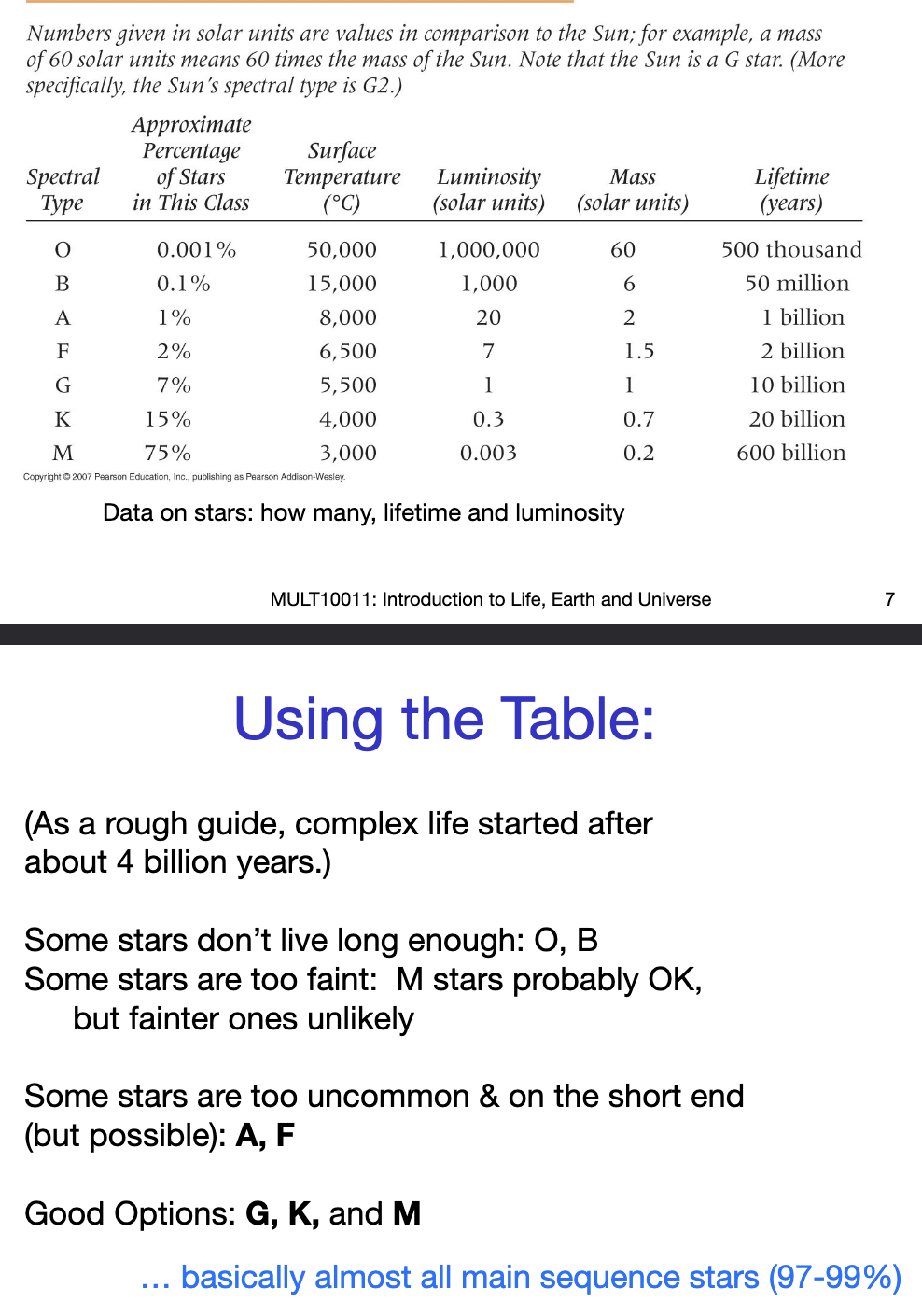
What are binary star systems?
Binary star systems are systems in which two stars orbit around a common center of mass due to their mutual gravitational attraction. They're actually quite common in our galaxy.
Planets can exist in these systems.
Why aren’t binary star system orbits circular?
A syste with single transiting planets have large eccentricity, where ones with multiple are on nearly curcular orbits.
If two growing planets have a close encounter, their mutual gravity could sling them off in odd directions, perhapts turning them into some eccentric orbits.
Are circular orbits important for life?
Yes.
Stability of location: highly elliptical orbits cause scattering of the planets.
Stability of the temperature: almost certainly important for the development of life.
Why is it easier to find a planet closer to its star?
LLook up observational biases and selection effects.
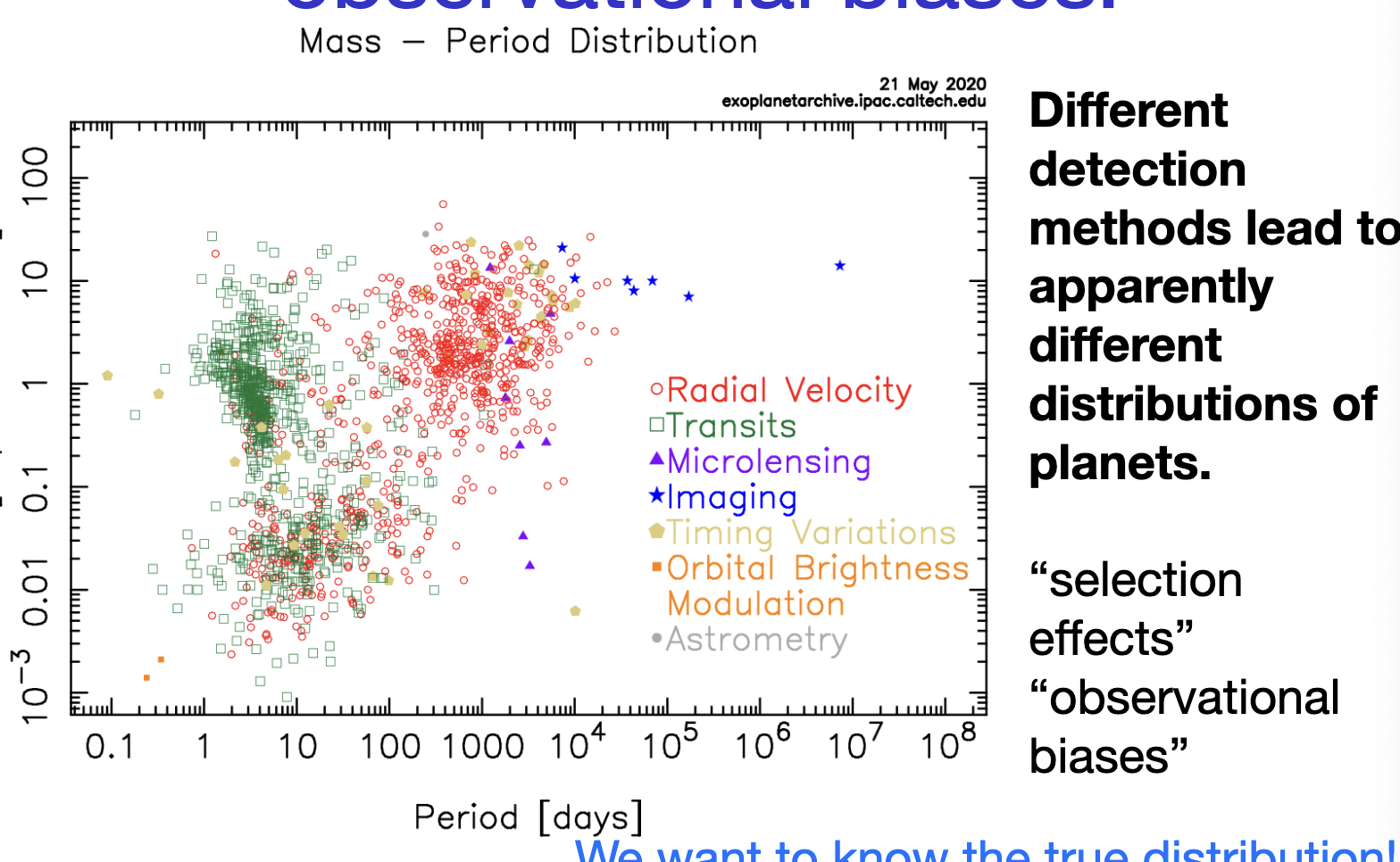
What are super earths?
Super-Earths are a class of exoplanets that are more massive than Earth but less massive than ice giants like Uranus and Neptune.